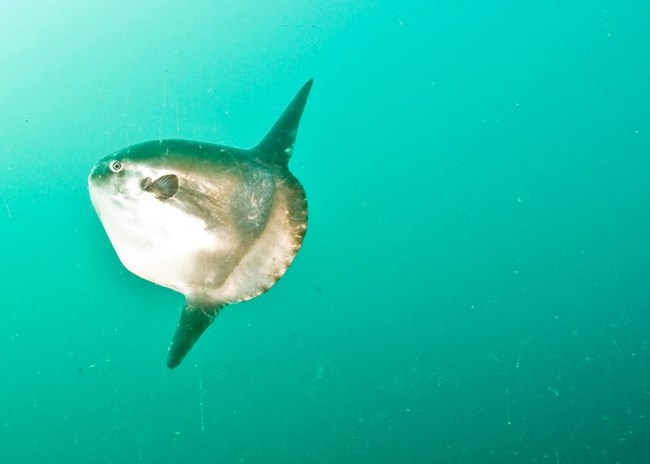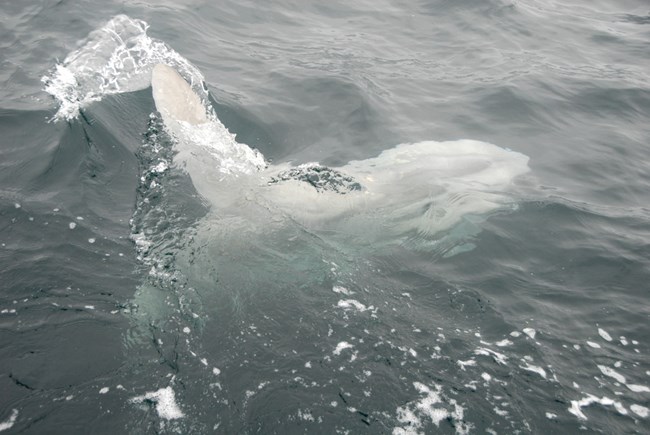Last updated: October 14, 2021
Article
Ocean Sunfish: Gentle Giants now found in Acadia's Waters

NPS Photo
What is an ocean sunfish?
Ocean sunfish (Mola mola) hold the record as the world’s largest bony fish, reaching maximum weights of 5,000 pounds. Ocean sunfish have been spotted along Acadia National Park’s coastline more frequently in recent summers, fascinating tourists and locals alike. They are oddly shaped, commonly described to look like half a fish. They have a round body that is flattened from side to side, two tall fins extending from the top and bottom, and no obvious tail. When swimming upright, these gentle giants are often mistaken for sharks because of the way their dorsal fin rises from the water. The tail fin is replaced with a short rudder-like structure, which the sunfish uses to swim independently of the current.
Ocean sunfish are found in near-shore oceans all over the globe. On the east coast of North America they range as far north as Newfoundland, however they are more common closer to the equator in waters warmer than 54° F. Ocean sunfish are considered unusual visitors in the Gulf of Maine, which may only reach that temperature in the hottest part of summer. In the northern part of their range, including the waters adjacent to Acadia, ocean sunfish have been observed laying on their sides at the surface of the water. This behavior is thought to be a form of sunbathing, which helps warm them up after hunting in cooler, deeper waters.

NPS Photo
Viewing Ocean Sunfish
Historically, ocean sunfish were uncommon in the Gulf of Maine. Even now, most reports come from deeper waters off the coast, with decreasing occurrence closer to shore. However, sightings of ocean sunfish in the Gulf of Maine and Mount Desert Island's Frenchman Bay are on the rise. This increase is more obvious in the summer months, when the ocean is warmest.
Boat tours around Frenchman Bay and other coastal waters offer the best chance to see ocean sunfish in the wild. When boating, it is most common to see sunfish basking in the sun just below the water’s surface. Keep your eyes peeled, though, for another behavior: despite their apparent lack of a tail, these powerful swimmers can breach up to 10 feet out of the water and come crashing back down with a fantastic splash!
Why are we seeing more of them?
Worldwide, populations of ocean sunfish are decreasing, and the species is listed as vulnerable by the International Union for the Conservation of Nature. However, this trend is locally reversed in Maine. One possible reason for increasing reports is linked to familiarity; as people become aware of the fish, they notice them more frequently. However, the more likely explanation is tied to climate change.
The NASA Earth Observatory has shown that the Gulf of Maine is warming 99% faster than the global average, shifting many species’ ranges further north. In August, ocean temperatures near Acadia have been recorded to reach highs of 58° F with some records as high as 63° F. This is well within the preferred range of ocean sunfish. In addition, warming oceans have led to an increase in summer populations of sea jellies, also known as jellyfish. These invertebrates are the preferred diet of the ocean sunfish, so more jellies may mean more sunfish.
How to help these incredible animals
With a few simple actions, you can help safeguard these incredible animals into the future. First, challenge climate change by reducing your carbon footprint, which helps preserve the marine habitat of ocean sunfish. Second, discarded plastic bags pose a significant threat to ocean sunfish. In the water, these greatly resemble sea jellies, and are often eaten by mistake. Making choices to help the ocean sunfish can have a lasting impact for the entire health of the world's oceans.
